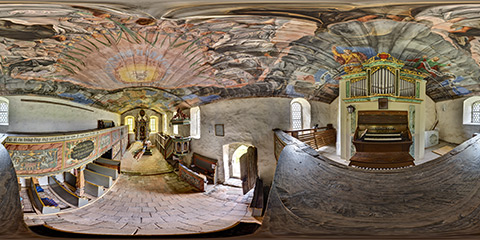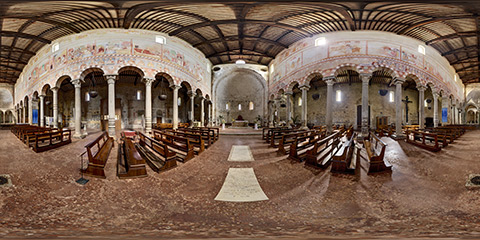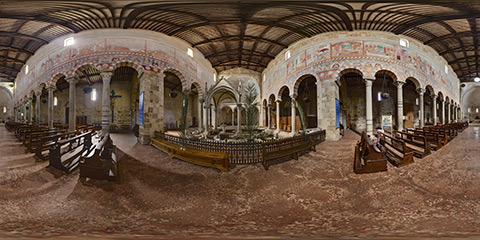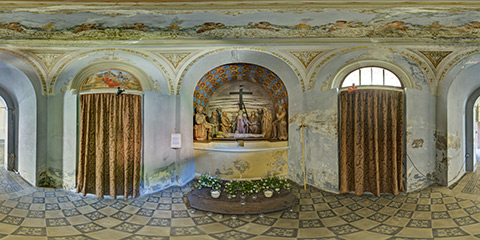» Church Interiors «
In addition to the religious aspect, churches are always an expression of zeitgeist, art and power. While the powerful were able to afford the best builders and artists of their time, there were also communities in small towns and villages that left us with evidence of great art.
If a religion or its affiliates were repressed, the respective places of worship were in many cases further used and adapted to the new religion. Here you will also find examples of former churches that are now used as mosques.
Santi Maria e Donati on Murano (Venice)
The Basilica dates back to the 7th century. After several rebuilds it received its present form in the 12th century. The marvellous mosaic flooring, which was extensively restored between 1973 and 1976, dates from this period.
Iglesia Parroquia de San Juan Bautista, Remedios (Cuba)
Although the church dates back to 1692, significant parts of the building, such as the wooden ceiling and the gilded altar, were not built until the first half of the 18th century. For fear of pirates, the gold of the altar had been painted over with white paint. Only during restoration work in the 20th century was the gilding rediscovered. One of the special features of the church is a statue of the Virgin Mary in which she is not only depicted pregnant but also dancing.
Dome in Pienza, Tuscany
In 1458 Aeneas Sylvius Piccolomini, born in Corsignano in 1405, was elected Pope. He gave himself the name of Pius II and decided to rename his birthplace Pienza and to transform it into a model city of the Renaissance. The architect Bernardo Rossellino received the commission. Work on the cathedral began in 1459.
The location directly on the slope of the town hill led to a lowering of the ground. This can be clearly seen from the crack that runs right through the floor tiles and the wall (in the panorama covered by a column). In order to detect changes in the crack, the wall was equipped with several measuring instruments. Currently (2020) extensive restoration work is underway. - UNESCO World Heritage since 1996
Notre Dame Du Sablon in Brussels
Construction of the Gothic church Notre Dame du Sablon began at the beginning of the 15th century and lasted for more than 100 years. The colourful glass windows from the 19th and 20th centuries are very impressive.
Surp Krikor Lusavoriç, Armenian Church in Kayseri (Cappadocia, Turkey)
First mentioned in 1191 this is the oldest and most important Armenian church in Anatolia. In the middle of the 19th century it was endangered to collapse and was completely rebuilt. Today it is the only Armenian Church in Anatolia which is still used for celebrations.
Russian Orthodox Theotokos Cathedral in Vilnius (Lithuania)
Built in the middle of the 14th century, this is the oldest church in Vilnius. After severe damage in World War II, it was restored from 1948 to 1957. Today it serves the Russian Orthodox community as a church.
Roman Catholic Dome San Salvatore in Cefalu (Sicily)
Under Roger II. construction began in 1131. The last major additions were made in 1471. The mosaic in the apse, created from 1148 onwards by Byzantine artists from Constantinople, is the central eye-catcher inside. UNESCO World Heritage.
Protestant village church in Waltersdorf (Brandenburg, Germany)
A simple stone building from the 12th century contains a colourful church. The church had been built by Flemings who had moved here from their coastal homelands after terrible destructions of a big flood. The rich décor is a donation of the landlord Johann Heinrich Berger and his children, after beeing ennobled in 1717 by the emperor Karl VI. The paintings were done by Joseph Gerlach in 1754. Next to the altar the landed gentry sat behind the open wooden sliding windows. If the windows were closed, this was an unmistakable signal for the priest to finish his sermon.
The angel which is tied to a rope was used for baptising. Originally the churches had a baptismal font, but in baroque times many churches became to small for all the believers who wanted to join the mass. To get more space, the baptismal font was taken away and replaced by an angel. Tied to a rope, the angel was pulled to the roof and dropped down when needed. The angel's arms carried a basin with the water needed for baptising.
For a long time the church was threatened by decay. The roof trusses were gnawed by the wood tick and the walls were threatened by the wall sponge. After several years of renovation, the reopening was celebrated on 26 July 2020.
Peterskirche in Lindau (Bavaria)
The Peterskirche is the oldest church in Lindau which dates back to the 9th century. The oldest wallpainting, Christophorus (around 1300), is opposite the main entrance. The wall next to it shows the so-called Lindauer Passion (1485-1490). If Hans Holbein the Elder was the painter is a controversial issue. Around 30 years later, apse and surroundings were painted by Mathis Miller from Lindau. In 1928 the church became a memorial for the war victims and in 1981 for the victims of the National Socialism.
Holy Spirit Churchin Bale (Istria, Croatia)
The small stone church was built in the 15th century and contains colourful frescoes, painted by Master Alberto di Constancia.
San Domenico in Arezzo (Tuscany)
San Domenico is a single nave church building from the 13th century. Its walls are richly decorated with frescoes made by local artists up to the 15th century. The most important work of art is the cross floating above the altar, created by Cimabue between 1260 and 1270. Cimabue was the nickname of the Florentine artist Cenni di Pepo, who later became Giotto's teacher.
San Piero a Grado (Tuscany)
This Romanesque church was built around 1005. Its importance comes from the frescoes, painted by Deodati Orlandi around 1300. The middle row shows the life of St.Peter, underneath all the popes from St.Peter to Johannes XVII (1003).
romanesque-gothic cathedral in Sovana (Tuscany)
The oldest traces of the church date back to the 9th century. The stock of the 11th century is secured and afterwards it was rebuilt several times. Additional pillars and arches were added towards the chancel, as the columns were originally designed for a wooden roof.
San Giovanni Battista in Matera (Basilicata)
This church was built between 1229 and 1236 and replaced a Benedictine chapel. The church was outside the city walls and belonged to nuns. In 1480 the church was abandoned by the nuns, because they suffered constantly from soldiers' raids. More than 200 years later reconstructions started and went on for the next 100 years.
Chiesa di San Domenico in Martina Franca (Apulia)
This baroque church was built in 1745 by the Dominican monk Cantalupi. It is attached to a Dominican convent from the 15th century. The interior contains five altars, made of polychrome marble, and paintings from Domenico Carella and Pietro De Mauro (2nd half of the 18th century).
Cathedral San Nicolò in Noto (Sicily)
After an earthquake in 1693 Noto was rebuilt about 6km away. From 1694 onwards, this included the new main church, whose baroque façade was completed in 1770. 200 years later, the building became dilapidated. Heavy rainfall in March 1996 led to the collapse of the dome and roof. Four years later, reconstruction could be started, which lasted until 2007. In 2009, the Russian artist Oleg Supereco began painting the frescoes, which were inaugurated with a ceremony in 2011. Since 2002, Noto and the towns of Val di Noto have been included in the UNESCO World Heritage list.
Chiesa di San Michele in Foro, Lucca (Tuscany)
Lucca is a town that is somewhat atypical for Tuscany. While most of the villages were built on a hill, Lucca is completely flat. Surrounded by a 4km long city wall, large parts of the historical townscape have been preserved. The Chiesa di San Michele was built on the site of the ancient Roman forum and was given the additional name "in Foro". Its construction began in 1143.
Chiesa di S.Croce in Brisighella (Emilia Romagna)
In the 16th century, this small church was built as an oratory for the Brotherhood of S. Croce. Opposite the confessional there is a restored 16th century painting by Gian Battista Bertucci. The bird cages hanging from above are used for festivities where white pigeons are allowed to fly. A small chapel next to the entrance is dedicated to a group of terracotta figures gathered around the deceased Christ (15th/16th century).
Nikolai Church in Jüterbog (Brandenburg, Germany)
Curch with three naves, built between the 13th and 16th century.
Hagia Eleni in Sille (central Anatolia, Turkey)
According to an inscription above the entrance, the church had been founded in 327 by Helena, mother of Konstantin the Great, on her way to Jerusalem. The image was shot during the restauration works in 2012. Meanwhile the church serves as a museum.
12 Apostles Church in Özlüce (Cappadocia, Turkey)
The Eski Cami-i (= old Mosque) in Özlüce (the old name is Syllata) had been built in 1849 as a Greek church and 1935, after the Turkish-Greek peoples exchange, it became a mosque. Like the Meryem Ana church in Nevşehir, this one has a turnable "pillar" next to the entrance too.
Cumhuriyet Camii in Derinkuyu (Cappadocia, Turkey)
This Greek Orthodox church from 1860 had been turned into a mosque in 1949 and is called Cumhuriyet Camii. It is one of the rare examples with an iconostasis. Also the wallpaintings have not been painted over. Only religious figures were covered. Better than in all the other Greek stone churches one can get an inpression of the original atmosphere.
Fatih Camii in Develi (Cappadocia, Turkey)
This Armenian church from 1905 has been changed into a mosque. In the former Armenian quarter are still some nice old houses.
Hagia Panagia in Talas (Cappadocia, Turkey)
The old Greek Panagia Church from 1886 is now called Yeni Cami (New Mosque) and serves today as a mosque. It is in the former city of Talas, which was populated by many Greek families until 1923.
former church in Çarıklı (Cappadocia, Turkey)
Çarıklı is a small village in the province of Niğde. Nothing reminds to the former christian inhabitants, except the 19th century church, which had been turned into a mosque in 1924. This happened directly after the Greek-Turkish population exchange. This may explain why there are no traces of the Greeks here.
former Greek Orthodox church in Dikilitaş (Cappadocia, Turkey)
Dikilitaş (Greek Enehil) is a small village in the province of Niğde. Before the peoples exchange between Tukrey and Greece in 1923 about 200 Greek and 80 Muslim families lived here. The church had been built in the middle of the 19th century. It is probably dedicated to St.George. Directly under the gable is a stone relief, showing St.George on a horse with a lance in his hand. Until 2008 (?) the church was used as a factory for hand knotted carpets. According to the people in the village they have knotted the biggest (160m²) carpet of Turkey.





























